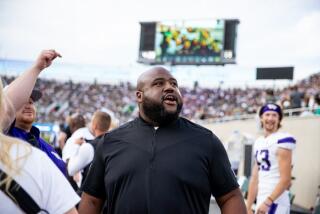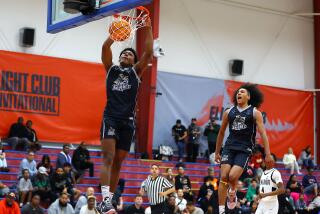Georgetown’s Alonzo Mourning Still Has a Lot of Learning to Do
- Share via
WASHINGTON — Sometimes, it is difficult to remember: Alonzo Mourning is just a college freshman.
He doesn’t talk like a college freshman. He doesn’t act like a college freshman. And he certainly doesn’t play basketball like a college freshman.
For example, it took him exactly three games to accomplish two things Patrick Ewing did not manage during four seasons at Georgetown. In the Hoyas’ 95-62 victory over St. Leo on Dec. 7, the 6-foot 10-inch center from Chesapeake, Va., scored 11 points, grabbed 10 rebounds and blocked 11 shots.
The “triple-double” was the first by a Georgetown player since John Thompson became the school’s coach in 1972. And the 11 blocks exceeded by one Ewing’s single-game school record.
Now, with his collegiate career at the ripe old age of 10 games, Mourning is averaging 13.3 points on 63.5% field-goal shooting, 7.6 rebounds and 6 blocked shots per game. In contests against De Paul and 10th-ranked Seton Hall, he averaged 18.5 points on 64.7% field-goal shooting, 8 rebounds and 8 blocked shots.
But keep in mind Alonzo Mourning is just a freshman--although one with talents far beyond his 18 years.
“Before I played my first game of college basketball, I knew that people would expect a lot from me,” he said Friday in one of his first extended interviews since being permitted by Georgetown to speak with the media Jan. 1. “But I had to take that under consideration because I know that I’m human, and I know that I’m not going to go out and score, like, 50 points every game. But that’s the way they perceived it to be in some of the magazines. They perceived me to be the big man on campus and all that.
“They fail to realize that I’m still a freshman, and all freshmen have to go through that learning experience and they have to adjust to college basketball and adjust to playing against that much talent every night. You have to adjust to going to school and also to playing with your teammates. You have to conserve your time, like getting the right amount of rest and eating the right foods and stuff like that.”
“Stuff like that” might be Mourning’s only concession to teen-agerdom. He says that when he was invited to try out for the Olympic team, “It was kind of shocking to me.” But what happened after that was anything but.
“Well, if they didn’t know that I had the talent to make the Olympic team, I would have never gotten the invitation,” he said. “So anything I did shouldn’t have been a surprise to me. They saw the talent in me and they just wanted to see more of it. I came out and just did what I had to do in the situations I was in.”
And of Thompson’s decision not to bring him to Seoul?
“I think he was right--I know he was right--because I’m a freshman and I didn’t really need to miss my first semester of school for basketball. Basketball is going to be there, regardless. The Olympics aren’t going anywhere; they happen every four years. So, in ’92 they’ll still be there and hopefully I’ll still be playing ball.”
He says he feels “just like any other student on campus” and “nobody on campus treats me any differently.” He likes it that way.
“I wouldn’t want them to treat me any differently. I hope they will look at me as a student instead of as a big-time basketball player.”
Yet, he does not pretend. He knows that, in addition to being a student, he is a big-time basketball player.
Said Mourning: “I wouldn’t call it a burden. I know if Coach puts me in that position, that’s where your maturity comes in. You have to learn to adjust to that situation, If you’re in crunch time and the ball has to get inside, you have to know what to do with it.”
More accurately, you have to have learned what to do with it. And Mourning has learned from some of the best.
“Trying out for the Olympics and playing against all that talent while being the youngest player out there really molded me to the point where I was ready,” he said. “I was comfortable in the college atmosphere I was in, so I didn’t really have to all of sudden adjust to it.
“Just by playing against that talent, I learned. So, when different situations happened to me in college, I was pretty much comfortable with them because I had been through them already.”
Mourning seems to have gained something more than just basketball knowledge from Ewing. He seems to have gained a sense of what it means to be in a position similar to Ewing’s.
Mourning said, “I can’t do poorly in my schoolwork. Just wearing that jersey is a big honor.”
That jersey is No. 33, the one Ewing wore at Georgetown. Mourning said he began wearing No. 33 as a junior-varsity player in high school.
“I started liking Georgetown when they played North Carolina (in the NCAA final), when Patrick was a freshman,” Mourning explained. “I like Kareem (Abdul-Jabbar), too. In junior high, I wore No. 6 because I liked Dr. J (Julius Erving).”
He added that Ewing “is not really why I took the No. 33, but it fits somewhere in there.”
“It was great what Patrick did,” Mourning said, “but it’s going to be hard to follow in Patrick’s footsteps because he’s done so much for Georgetown. That’s why I have to make my own path and do something different from what he did.”
More to Read
Go beyond the scoreboard
Get the latest on L.A.'s teams in the daily Sports Report newsletter.
You may occasionally receive promotional content from the Los Angeles Times.










